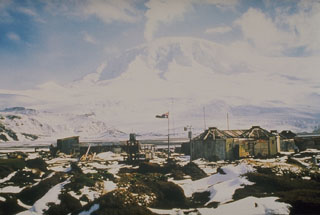Report on Heard (Australia) — February 2001
Bulletin of the Global Volcanism Network, vol. 26, no. 2 (February 2001)
Managing Editor: Richard Wunderman.
Heard (Australia) Increased fumarolic activity in February and March 2001; possible lava flow
Please cite this report as:
Global Volcanism Program, 2001. Report on Heard (Australia) (Wunderman, R., ed.). Bulletin of the Global Volcanism Network, 26:2. Smithsonian Institution. https://doi.org/10.5479/si.GVP.BGVN200102-234010
Heard
Australia
53.106°S, 73.513°E; summit elev. 2745 m
All times are local (unless otherwise noted)
Fumarolic activity emanating from Big Ben stratovolcano on Heard Island increased since the previous report period of October-November 2000 (BGVN 25:11). Both the vent at the summit of Mawson Peak and the second, recently confirmed vent downslope from the summit, were involved in the activity in early February 2001.
At about 2100 on 2 February an increased emission of volatiles was observed from Atlas Cove, located ~15 km NW of the summit where the main island connects with the Laurens Peninsula (see maps in SEAN 10:02 and BGVN 23:02). Under daylight the plume had a yellow-colored tinge. By midnight venting increased substantially. Observations continued until 0100 on 3 February when emissions appeared to diminish and clouds obscured the view. No lava or ejecta were observed from the Atlas Cove vantage point.
The plumes rose up to ~1,000 m in height, but tended to vary in extent over time. The precise points of emission were hidden by the high shoulder of Big Ben. Nevertheless, the emissions appeared to emanate from two discrete vents, one at Mawson Peak, and the other the newly discovered vent estimated to be 300-400 m vertically below it (lower than previously thought) on the S-facing slope.
Observations on the afternoon of 3 February revealed further abatement of volatile venting. Some workers suggested the presence of a third vent based on observations from Anzac Peak on Laurens Peninsula at the NW end of the island, but these findings are not yet substantiated. From a high point on Laurens Peninsula a black lava flow (?) on Mawson Peak was observed to be closer to the Atlas Cove side of the island than on previous visits. The possible flow was ~100 m wide and ~1,500 m long, but size estimates were hindered by distance, the enormity of Big Ben, the lack of any comparative scale, and the acute viewing angle.
On 5 March observers obtained good views of Big Ben from Red Island, at the farthest N tip of the Laurens Peninsula, but were unable to discern any summit activity despite clear conditions. Further observations from the same vantage point at 1330 on 7 March afforded a brief 5-8 minute view of the summit and revealed that a significant plume rose 100-200 m and drifted several kilometers downwind. The plume's width was estimated to be 50 m. The "black scar" first viewed on 3 February and interpreted as a plausible lava flow was again visible and appeared unchanged since its last observation.
The findings in early February and March 2001 are consistent with recent observations during a helicopter overflight of Big Ben that confirmed the presence of a vent well below the summit of Mawson Peak (Kiernan & McConnell, 2000). They compound the likelihood that more than one vent was involved in earlier eruptive activity during 1950-52 and 1985 (ANARE Station Reports; Neumann van Padang, 1963), contrary to recent conclusions by Quilty & Wheller (2000). Observations of volcanism on Heard Island, however, are limited because of its remoteness, and since the summit area is frequently shrouded in clouds. Hence, the general level of activity observed recently is difficult to assess.
References. Kiernan, K., and McConnell, A., 2000, ASAC Project 1118, Geomorphological Evolution of Heard Island: Report to Atlas Cove Station Leader, ANARE.
Neumann van Padang, M., 1963, Arabia and the Indian Ocean: Catalogue of the Active Volcanoes of the World, v. 16, p. 1-64.
Quilty, P.G., and Wheller, G., 2000, Heard Island and the McDonald Islands: A window on the Kerguelen Plateau: Papers & Proceedings of the Royal Society of Tasmania, v. 133, no. 2, p. 1-12.
Geological Summary. Heard Island on the Kerguelen Plateau in the southern Indian Ocean consists primarily of the emergent portion of two volcanic structures. The large glacier-covered composite basaltic-to-trachytic cone of Big Ben comprises most of the island, and the smaller Mt. Dixon lies at the NW tip of the island across a narrow isthmus. Little is known about the structure of Big Ben because of its extensive ice cover. The active Mawson Peak forms the island's high point and lies within a 5-6 km wide caldera breached to the SW side of Big Ben. Small satellitic scoria cones are mostly located on the northern coast. Several subglacial eruptions have been reported at this isolated volcano, but observations are infrequent and additional activity may have occurred.
Information Contacts: Stu Fitch and Andrew Lock, Australian Antarctic Division, Channel Highway, Kingston, TAS 7050, Australia (URL: http://www.antarctica.gov.au/); C.J. Klok, Department of Zoology and Entomology, University of Pretoria, Pretoria 0002, South Africa (URL: http://www.up.ac.za/zoology-entomology/); Kevin Kiernan and Anne McConnell, Geography & Environmental Studies, University of Tasmania, GPO Box 252-79, Hobart TAS 7001, Australia.

